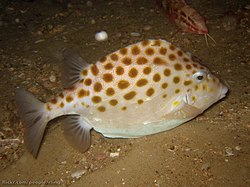| Aracanidae Temporal range: | |
|---|---|
 | |
| Anoplocapros inermis | |
| Scientific classification | |
| Kingdom: | Animalia |
| Phylum: | Chordata |
| Class: | Actinopterygii |
| Order: | Tetraodontiformes |
| Suborder: | Ostracioidea |
| Family: | Aracanidae Hollard, 1860 |
| Genera | |
see text | |
Aracanidae, the deep sea boxfishes or temperate boxfishes, are a family of marine ray-finned fishes belonong to the order Tetraodontiformes, which also includes the pufferfishes, triggerfishes and ocean sunfishes. The fishes in this family are found in the Indo-West Pacific region, particularly in the waters around Australia.